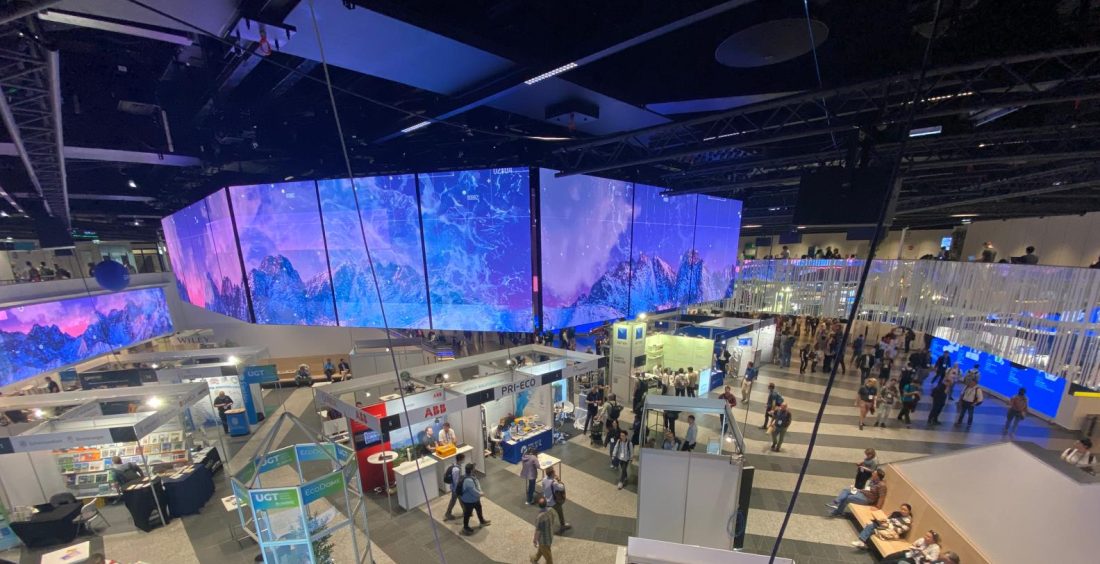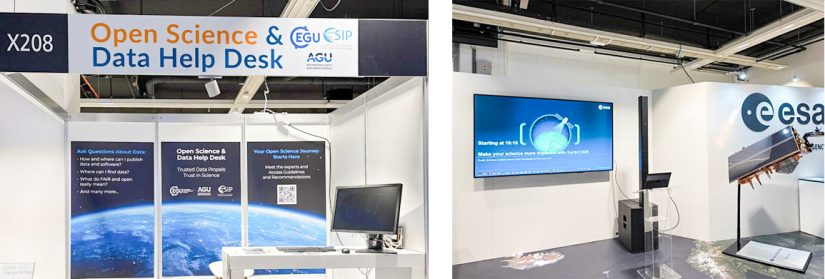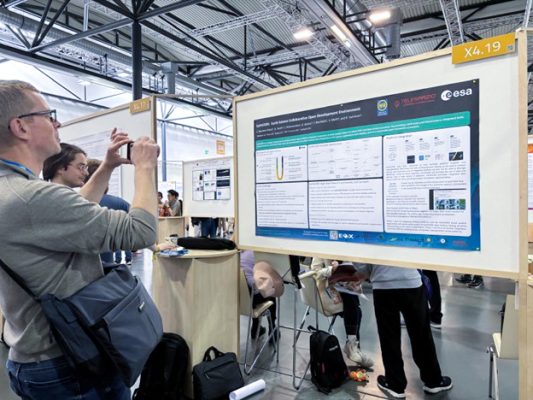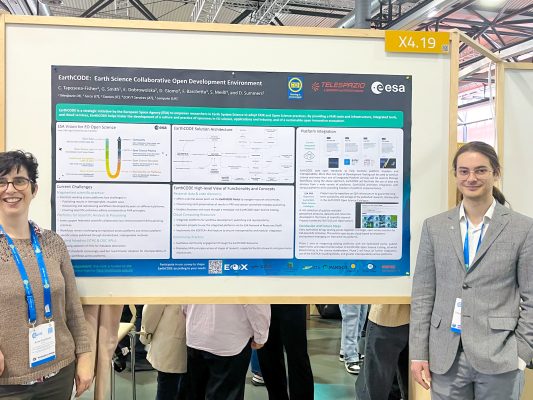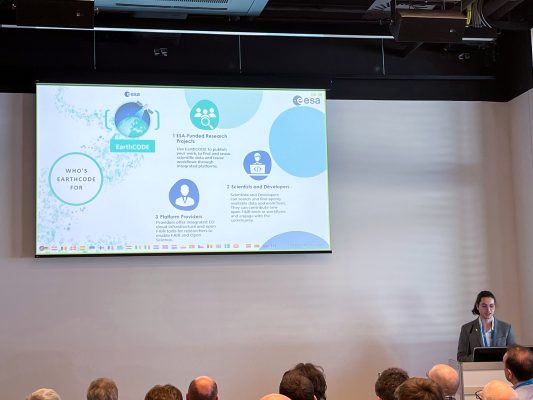The EGU General Assembly 2025 program placed a strong emphasis on Open Science across its scientific sessions, short courses, townhalls, and networking events. Key activities centered on four core themes: FAIR and open data, FAIR workflows, interoperability & reproducibility, and open-source initiatives. These themes resonated across disciplines and engaged key stakeholders. Prominent among these were ESA initiatives such as EarthCODE, APEx, or EOEPCA+, demonstrating the collective drive toward transparency and reproducibility in geoscience and remote sensing research.

FAIR and open data
A dedicated session titled “One decade of FAIR Principles: Data Reusability and Impact in Earth System Sciences,” reflected on the community’s progress in implementing the FAIR data guidelines nearly ten years after their introduction. Contributions from across Earth science disciplines highlighted advances and ongoing challenges in making research data findable, accessible, interoperable, and reusable (FAIR).
An Education and Outreach session focused on the “open era” of science – how data/software repositories, open-access publishing, and virtual platforms enable collective development and sharing of resources. It showcased community-driven initiatives (online learning hubs, transdisciplinary databases, open software, etc.) and discussed their benefits (improved communication and collaboration) and hurdles (funding and recognition). The resounding message: open data and knowledge-sharing are fueling scientific advancement, even as most such efforts rely on grassroots support.
The program also highlighted international efforts to institutionalize open data practices. For example, a splinter meeting by the Group on Earth Observations Data Working Group addressed strategies to promote worldwide adoption of open data-sharing and management principles and to advance the interoperability of Earth observation data. This forum brought together data policy experts and scientists to discuss legal/ethical issues, standards, and best practices for making geoscience data broadly usable across platforms and disciplines. Such initiatives stress that enabling global data access – across national and disciplinary boundaries – is critical for tackling environmental challenges.
The European Space Agency’s Open Science initiatives were prominent across the EGU 2025 programme, underscoring ESA’s commitment to making Earth science data openly available and easily usable – as stressed in its recently updated Science Strategy – in alignment with the FAIR and open data principles.
The EOEPCA activity was presented in the session “Collaborations, Tools and Services Towards an Integrated Research Data Infrastructure” as a common architecture for Earth Observation platforms to federate data services and improve user access to the rapidly growing volume of satellite data. Interoperability through open standards is a key goal of this ESA initiative, facilitating platform-to-platform data exploitation.
In the same session, the integration of ESA’s Climate Change Initiative open data portal with Europe’s other major data systems (the Copernicus Climate Data Store and the Destination Earth digital twin) was discussed as a step toward a more unified climate data ecosystem.
The EGU Open Science & Data Help Desk ran throughout the week to assist researchers with making their data and software more FAIR and transparent. ESA’s new EarthCODE initiative – which stresses openness of research data as a foundational element – was prominently featured at the Help Desk, as well as at the ESA Booth, where it shared best practices for FAIR data management and demonstrated how researchers can publish and share data in a FAIR-compliant way across platforms.
Furthermore, the openEO project showcased how standardized data access can advance the open-data agenda. In their oral presentation “How openEO standardizes workflows for scalable and reusable EO data analysis”, openEO developers demonstrated how their API standardizes access to distributed Earth observation data and processing, enabling users to run the same analysis on different backends seamlessly. By hiding the complexity of multiple cloud platforms behind a common interface, openEO makes data more findable and accessible to scientists – a direct contribution to FAIR data principles.
ESA’s APEx initiative – a new ESA project launched in April 2024 designed to streamline the transition of EO research results into operational cloud services – was also prominently highlighted at EGU 2025 in Earth and Space Science Informatics session ESSI2.7 on bridging user needs with sustainable data solutions.
FAIR workflows
Recognizing that Open Science goes beyond data, EGU 2025 highlighted research processes. , The session “Scalable and FAIR Workflow Approaches in Earth System Science: Addressing Data and Computational Challenges” showcased methods and tools for making complex simulations and analyses more transparent and reusable, even with growing data volumes and model intricacy. Presentations demonstrated how well-documented, standardized workflows can facilitate replication of results and sharing of methods across different teams. EarthCODE contributed with a poster presentation to this session, highlighting its solution for publishing and reusing analysis workflows across federated cloud environments, to make Earth system science more reproducible and FAIR for the community. As EarthCODE has begun integrating with major open-data platforms (e.g., the openEO federation on the Copernicus Data Space Ecosystem, the Euro Data Cube, DeepESDL, among others), the presentation stressed the value of collaboration across the platform ecosystem.
Additionally, in the session “Seamless transitioning between HPC and cloud in support of Earth Observation, Earth Modeling and community-driven Geoscience approach PANGEO”, EarthCODE’s oral presentation explored how the initiative leverages the Pangeo ecosystem to support cloud-native, reproducible science.
Hands-on short courses provided training in open, scalable workflow tools. Notably, a course on harnessing the power of Pangeo introduced participants to an ecosystem of open-source Python tools (centered on Xarray for N-dimensional data and Dask for parallel computing) to scale up scientific data analysis workflows. Attendees learned to run analyses on cloud or HPC resources with minimal code changes, using the free Pangeo@EOSC platform and offering all materials and software in this course with open license.
Interoperability and reproducibility
A Union-wide townhall titled “Science, No Fiction: The Environmental Open Science Starship Returns to Earth” invited researchers to chart new horizons in Open Science by imagining fully integrated global datasets, tools, and research infrastructures beyond traditional silos. During the session participants discussed how connecting data repositories and platforms across nations and disciplines could revolutionise the way science is done. They examined technical and cultural obstacles to this vision and brainstormed solutions to break down those barriers. The townhall drew insights from major international projects and research infrastructures (e.g. EPOS, ICOS, EarthCube, ENVRI) as examples of how interoperability can enhance research impact. This cross-cutting dialogue underscored that achieving reproducible, interoperable science at scale requires global coordination – but the next generation of scientists is poised to “take that giant leap” by embracing open data, open access, and shared infrastructure.
Open-source initiatives in Earth science
A scientific session on “Open source software tools in geosciences” highlighted the growing ecosystem of community-developed software in Earth science. Researchers demonstrated how open-source tools – from libraries for geological modeling and geospatial analysis to entire workflow frameworks – are being applied to drive innovation in their fields. The session emphasized that sharing source code and algorithms accelerates progress by enabling others to inspect, reuse, and improve these tools.
A special evening townhall, led by the grassroots Software Underground community, convened Earth scientists interested in open-source software development and the challenges/opportunities posed by new technologies. The meetup discussed the ethical use of AI (Large Language Models) in research and coding and how an open-source culture can help address those challenges. It stressed the value of collaborative environments and peer networks in strengthening professional relationships and promoting reliable, reproducible research practices.
EGU25’s short courses also reinforced open-source capacity building. In addition to the Pangeo course noted above, there were tutorials on the Julia programming language for climate and ocean modeling, workshops on open geostatistical software (e.g. the MUSE toolkit for uncertainty modeling), and demos of open-source libraries like GemPy for 3D geological modeling. These courses provided hands-on experience with free tools and encouraged participants to contribute to these projects. Importantly, all software and content used were provided under open licenses (e.g. MIT, Apache, CC-BY), allowing attendees to continue using and disseminating the tools beyond the conference. By lowering entry barriers to advanced techniques, such initiatives help democratize research and enable cross-disciplinary usage of powerful computational methods.
Open Science is inherently cross-cutting. The Assembly showcased how FAIR data practices, transparent workflows, reproducibility, and open-source tools are being integrated into virtually every geoscience domain, from climate modeling to seismology. Sessions co-organized between informatics experts and subject-matter scientists broke down silos, while Union-wide discussions and townhalls set a common vision for an open science future. Through initiatives such as EarthCODE, APEx, EOEPCA+, ESA contributes to aligning European Earth science with global Open Science principles, building a more accessible, inclusive, and impactful science.

